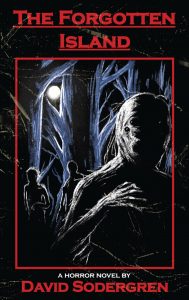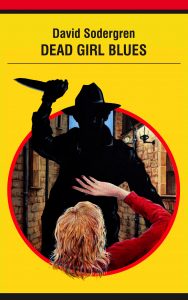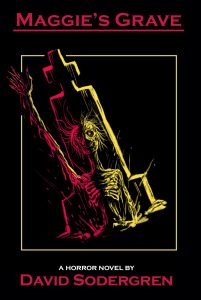1. Introducing David Sodergren
David lives in Scotland with his wife Heather and his best friend, Boris the Pug. Growing up, he was the kind of kid who collected rubber skeletons and lived for horror movies. Not much has changed since then. His first novel, The Forgotten Island, was published in 2018. This was followed by Night Shoot, a brutal throwback to the early 80s slasher movie cycle, in 2019.
2020 was Sodergren’s biggest year yet, with two new horror novels — the slasher-noir Dead Girl Blues, and the blood-soaked folk-horror Maggie’s Grave.
2. When did you start writing horror/speculative fiction?
I started when I was a child, writing three or four page sequels to my favourite horror films. I think my first was Child’s Play 3, probably the same year they actually made the real Child’s Play 3! I didn’t start writing professionally until 2017. That year, I wrote my first full length novel, which may never see the light of day but was excellent practice, before I published my very first novel, The Forgotten Island, in 2018.
 3. What would you consider to be your biggest influences on your writing style or approach to storytelling?
3. What would you consider to be your biggest influences on your writing style or approach to storytelling?
Oddly, my biggest influences are movies, not books. Horror and exploitation cinema of the 70s and 80s are key to my work. I write my books as movies I’d love to see, and visualise them in my head as I’m writing them. I like to take my favourite sub-genres and update them for a modern audience, which is why I’ve written a creature feature, a slasher, a giallo (Italian-style mystery thriller), and a folk horror.
Book-wise, the biggest influences on my writing — apart from Stephen King, obviously — are the novels of James Herbert and Shaun Hutson. They showed young David that you could write nasty, sleazy, violent horror and set it in the UK, which is something I like to do. Scotland is a terribly moody, atmospheric country, and makes for a terrific setting for a horror story.
Dan – you’re like my long lost twin. I have pretty much the exact same influences, right down to living in Scotland for 14 years.
4. What was the first thing you wrote that made you think ‘I’m a writer’?

I guess it was The Forgotten Island, though probably not until it was published and people started to read and enjoy it. I knew that I thought it was good — I wouldn’t publish something that I didn’t believe in — but I had no idea if others would like it. When they did, I realised I may be on to something.
5. Tell us about your biggest achievement or proudest writing moment to date?
It may not sound like much, but my proudest moments are whenever I see someone posting on social media about how much they enjoyed one of my books. The idea that someone has spent their hard-earned money on one of my stories, taken the time to read it, and then posted about it publicly…it’s always lovely to see, and I’m grateful to everyone who does that. Like many self-published authors, I can’t afford advertising, so word-of-mouth is the number one tool to get my books in front of readers.
Dan – yeah, ads are expensive. Your books are definitely killing it on word of mouth. It’s an impressive achievement. Readers are loving them and rightly so.
6. Now tell us about your lowest moment and how you overcame it? Go on, be a hero…
I suppose it’s simply battling with the constant crippling anxiety that I’m not good enough. I tend to write with a swaggering self-confidence, and then halfway through a story I think, “this is shit, scrap the whole thing”. I find that taking a month away from the story and then going back to it with fresh eyes usually puts things in perspective.
Dan – I’m the same except, I get a freak out just before the finale act.
7. Have you got any strange writing habits?
It’s maybe not strange, but before I start work on a story, I compile a playlist of appropriate music to listen to while writing. All instrumental, mostly soundtrack stuff. There can’t be any songs with lyrics, as I would inevitably start singing along. The playlist should be at least five hours long, as I’m gonna be hearing it a lot as I write…
8. What’s the hardest thing about being an author?
For me, juggling my writing with a full time job and a life outside of work too. I work at the day job, then come home, spend time with my wife, have dinner, play with the pug…before you know it, it’s approaching midnight, and I need to write. It’s tough, but if you want to write, you need to make the time. No excuses.
9. What is the best thing about being an author?
It’s the best job in the world. I get to sit and imagine the most awful things my twisted mind can conjure, and then share them with like-minded creeps and weirdos. Nothing beats the feeling of someone you don’t know messaging you out of the blue on social media purely to tell you how much they loved your book. It’s wonderful.
10. What attracts you to horror/speculative fiction?
What doesn’t? I’ve been obsessed with horror since I was a very, very young child. It’s in my blood. It infects everything I do. I can’t pass a cemetery without popping in for a visit. Want to get me to buy your product? Put a skeleton on the label. If I’m on holiday, I’ll look up local ghost stories and visit the location of the hauntings. I love horror and the macabre, always have, always will.
11. Who’s an indie author everyone should be reading but maybe they  haven’t heard of?
haven’t heard of?
A few spring to mind. Steve Stred is one. He writes bleak horror fiction, but his new book, The Future In The Sky, is a chilling dystopian sci-fi, and may be his best work yet.
Bradley Freeman should also be on everyone’s radar. Of particular interest to horror fans is his novel Reek, which combines the creeping unease of J-horror with found footage elements and 80s splatter.
John Bender wrote a wonderful horror-crime-heist story called Chainsaw, and hopefully there’s more to come from him.
And though she’s now a well-deserved Stoker-nominated author, Gemma Amor should still be better known. Start with Dear Laura. It’s incredible.
Dan – Steve Stred is great. Lovely guy too. He was our first interview on the blog as well.
12. What’s the first horror novel you remember reading? What impression did it make on you?
The first ‘adult’ horror novel I read was The Rats by James Herbert. I was eight years old, and though I probably didn’t understand everything that was happening, it undoubtedly changed my life.
Dan – I love The Rats too – gateway horror crack for sure.
13. What are you currently reading?
The biography of Paul Hirsch, famous Hollywood editor. I’m listening to the audiobook, as the only time I have for reading these days is on commutes.
14. Which monster from fiction – books, TV or film – would you most like to be and why?
The Mummy, because then I could sleep for thousands of years and get really cranky when someone wakes me up, which isn’t far off what I do these days anyway.
15. Which one of your books would be best adapted into a movie? And who would you cast in the lead roles?
Tough question. They’re all written rather cinematically, with special attention paid to things like lighting and editing (lots of cross-cutting to build tension in my books!) I don’t know about lead roles, but for directors, I’d love to see Dario Argento or Brian De Palma have a crack at Dead Girl Blues.
 16. Where did the idea for your last book come from?
16. Where did the idea for your last book come from?
My last book, the folk horror Maggie’s Grave, was inspired by a real life witch’s grave in Scotland. It’s the only monument of it’s kind in the UK, and sits in a field, towering over the roadside. An eerie, unsettling place, and the perfect inspiration for a horror story!
Dan – I live in Islandmagee in Northern Ireland. Its claim to fame is that it’s the location of the last woman to be tried as a witch. She was actually convicted, but survived and her house is still standing on the peninsula.
17. I love the old school horror covers of the 60s to the 1980s. I love your book covers too, and I think your wife designed them, is that right? What were you guys aiming to achieve with them?
Thank you! I always commission art for my books. I’ve used Trevor Henderson twice, and Connor Leslie twice. My wife handles the graphic design and layout. The goal is to produce something similar to the old paperbacks I love from the 50s to the 80s. I’m not a fan of most modern day traditionally published covers. Compare the covers of Stephen King’s 70s work with the modern day reprints…ugh! I’m sure it appeals to a more mainstream audience, but as an indie author, I need to hook the reader with a cover that screams ‘buy me’ as a thumbnail on Amazon.
18. Can you tell us something about your current ‘work in progress’?
I have three books on the go at the moment. You may see one this year, you may see all three! We’ll see how it goes. Can’t say much at the moment, I’m afraid, as I’m superstitious about revealing too much in advance, but fans of ultra-violent revenge stories are gonna be pretty pleased, I think.
Dan – you’re not alone there. Steve Stred told us he had about 19 books on the go. I think that might be a record.
19. What book of yours should people start with?
Hard to say, as I haven’t read any of them since I wrote them, but I’d say Maggie’s Grave or Night Shoot would probably be a good place to start.
20. Where can people stalk you online like a serial killer?
The usual places! Instagram @paperbacksandpugs at for photos of books and pugs, or Twitter at @paperbacksnpugs for movie reviews and general shenanigans. Definitely way more active on Twitter though.
21. Is there anything else you’d like to add?
Nope, except to say thanks for the interview, and to anyone reading, thank you too! Promote indie horror, and stay safe out there.



 haven’t heard of?
haven’t heard of? 16. Where did the idea for your last book come from?
16. Where did the idea for your last book come from?